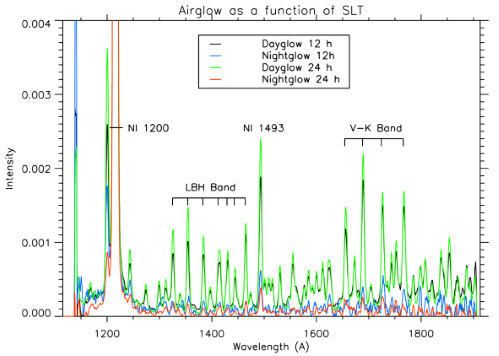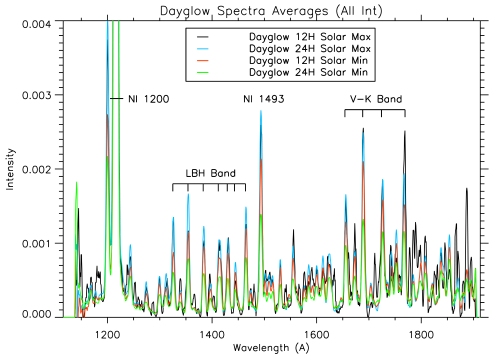Titan’s Ultraviolet Airglow Variability with Solar Cycle and Saturn Local Time
- 1Planetary Science Institute (PSI), Tucson, AZ, United States of America (emilieroyer@psi.edu)
- 2University of Colorado, Boulder, CO, United States of America
The Cassini spacecraft observed Titan’s upper atmosphere and its airglow emissions from 2005 to 2017. It is now established that the solar XUV radiation is the main source of dayglow, while magnetospheric particle precipitation principally acts on the nightside of the satellite. Nevertheless, one of the questions remaining unanswered after the end of the Cassini mission concerns the role and quantification of the magnetospheric particle precipitation and other minor sources such as micrometeorite precipitation and cosmic galactic ray at Titan. We report here on enhancements observed in Ultraviolet (UV) observations of Titan airglow made with the Cassini-Ultraviolet Imaging Spectrograph (UVIS). Enhancements are correlated with magnetospheric changing conditions occurring while the spacecraft, and thus Titan, are known to have crossed Saturn’s magnetopause and have been exposed to the magnetosheath environment. The processing and interpretation of 13+ years of airglow observations at Titan allows now for global studies of the upper atmosphere as a function of the Saturn Local Time (SLT) and the solar cycle.
Nitrogen airglow occur at about 1100 km of altitude in Titan’s upper atmosphere. Observations by the Cassini-UVIS instrument revealed the emission of the LBH band system, VK band system as well as Nitrogen atomic emission lines at 1085Å and 1493Å, as the prominent features of airglow emissions at Titan, as shown in Figures 1 and 2. Measurements were made at a wide range of solar incidence angles and Saturn Local Time (SLT), during the entire Cassini mission, allowing for the investigation of the upper atmosphere response to the magnetospheric environment and energetic particle precipitation. Additionally, observations were taken in a variety of solar condition, from solar maximum to minimum. UVIS observations of Titan around 12PM SLT (near Saturn’s magnetopause) present evidence of Titan’s upper atmosphere response to a fluctuating magnetospheric environment.

Figure 1. Airglow intensity as a function of the saturn Local Time (SLT), for observation taken close the Saturn’s magnetopause (12PM SLT, labelled ‘12h’) and observations taken around miadnight SLT (labelled ‘24h’). Dayglow spectra exhibit higher averaged airglow intensity than Nightglow spectra.
We present here comparisons of the spectral emissions from the dayglow (Solar incidence angle <110°) and nightglow (Solar incidence angle ≥110°) between a rayheight of 900-1200 km around noon (±1 h) and around midnight (±1 h) SLT, during solar minima and maxima conditions (Fig. 2). Results show an enhancement of the airglow brightness with increasing particle precipitation, especially at SLT close to noon (i.e. close to the magnetopause), during solar maximum and minimum. Correlation between the ratio of the V-K, LBH, and NI-1493Å emission peaks are also presented.

Figure 2. Dayglow intensity as a function of the saturn Local Time (SLT) and solar cycle. Observations have been dispatched in four groups as a function of Titan’s orbital position within Saturn’s magnetosphere and maximum oe minimum stage of the solar cycle. Results suggest that solar maximum conditions around midgnight SLT favor the apparition of the brightest dayglow.
In the past decade, results from the Cassini-UVIS instrument greatly improved our understanding of airglow production at Titan. However, combining remote-sensing datasets, such as Cassini-UVIS data, with in-situ measurements taken by the Cassini Plasma Spectrometer (CAPS) instrument can provide us with a more rigorous assessment of the airglow contribution and correlations between data from simultaneous observations of in-situ Cassini instruments (CAPS, RPWS and MIMI) has been possible on few occasions. UVIS results present here will be put in context with results from in-situ simultaneous observations.
How to cite: Royer, E., Cooper, M., Ajello, J., Esposito, L., and Crary, F.: Titan’s Ultraviolet Airglow Variability with Solar Cycle and Saturn Local Time, Europlanet Science Congress 2020, online, 21 September–9 Oct 2020, EPSC2020-415, https://doi.org/10.5194/epsc2020-415, 2020

